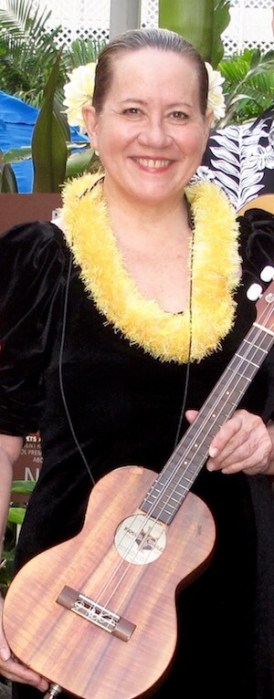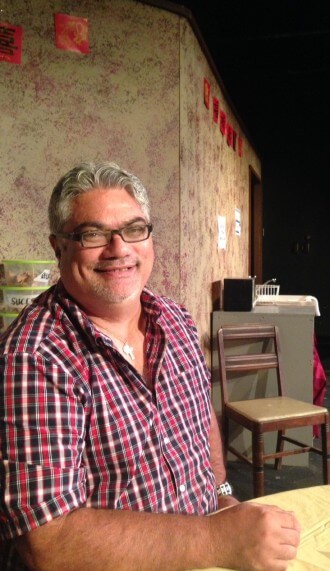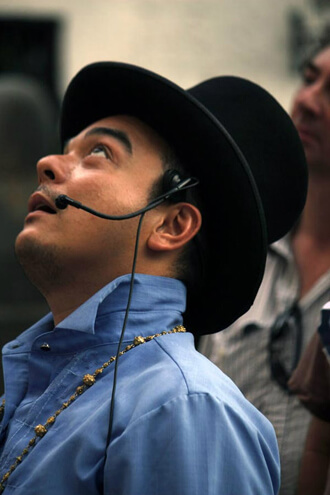David Noh with former classmate Diane Kimura during Punahou Reunion Week.
With my father’s recent death in Hawaii, the past year has been filled with rites of passage, and I recently took part in another one there, by going to my first Punahou School reunion. I attended Barack Obama’s alma mater from the sixth grade on, and for me this event was a biggie, something I’d sworn I’d never do, not knowing if, like that iconic ‘90s reunion film, I’d nervously be Romy, Michele… or maybe just Cumming.
You know what? It was fantastic — bonding with old friends as well as former students I’d never said a word to back then, with almost everyone mercifully freed from snotty high school cliques and cocoons of insecurity and fear. Punahou Reunion Week is an intense flurry of events that takes place every five years.
My first school reunion; Hawaii’s gay pioneer
At the all-important presentation of class gifts, I had a happy hugfest with fellow alumnus Joy Abbott, widow of Broadway eminence George Abbott. I thought our class’ donation of $63,000 was pretty impressive, but the class of 1963 rather handily outshined us with a whopping $1.3 million. “What is this?” I thought. “Broadway Cares?”
I was particularly grateful for the pre-reunion get-togethers — nice, cozy lead-ins to the bigger events with their daunting full-on nostalgia assaults. Facebook was on fire with hilarious reminiscences and barbed but good-humored communiqués firing on all sides, oiling the way to renewed intimacy. A huge mahalo (thank you) goes out to Chickie Guillaume, whom we deemed our class saint for her beautiful organizational skills and painlessly graceful coercion tactics, without which I never would have showed up for anything.
We had a riotous time at our former hangout, Eggs ‘n Things, and the centerpiece cocktail party at the Outrigger Canoe Club had nearly the intensity of an epic film, filled as it was with so many, many shared memories and renewed and brand new friendships. The traditional spreading of the ashes of recently departed classmates from a canoe into the waters of Waikiki lent solemn beauty to the occasion. I had a spectacular re-meet with Mavis Nikaido, my date for the ninth grade dance, as sweet and lovely as ever.
When I pulled into the parking lot of Mariana’s exquisitely preserved vintage tiki bar for the luau after-party, I was delighted to see three familiar classmates happily toking pot, just like they used to, as if nothing whatsoever had changed. Memories rushed back of our fabulously insane bus ride to graduation ceremonies, in which our class — deemed the most impossible by the faculty — fortified with champagne bottles, Kona Gold, and God knows what else, literally floated into commencement.
The reunion festivities culminated with a picnic at Bonnie Judd’s gorgeous 1920 estate in Kaneohe, a veritable Garden of Eden of gorgeous flora and fauna, everyone’s dream of Old Hawaii lifestyle, with Carla Rayacich singing Kui Lee’s haunting “Days of My Youth” and Kimo Conant Eagle giving us male hula to make your heart stop.
Jack Law, owner Hula's Bar & Lei Stand in Honolulu.
It can safely be said that there simply would be no gay life in Hawaii without Jack Law. The owner of the legendary Hula’s Bar and Lei Stand, soon to celebrate its 40th anniversary, he is also the founder of Honolulu’s gay Rainbow Film Festival and the Life Foundation, Hawaii’s AIDS organization.
How well I remember my first visit to Hula’s in its original magical location beneath a spreading, twinkly-lit banyan tree in Waikiki. “Hawaii has a real gay bar at last,” I thought — and what a bar, with its lovely old plantation ambiance, terrific music, and no less than the handsome Dayton Ka’ne, star of Dino DeLaurentiis’ 1979 “Hurricane,” as doorman. Many ravishing, intoxicating, and intoxicated nights followed, filled with laughter, dance-induced sweat, and new boyfriends, for romance was always truly in the air there.
I’ve known Jack for a long time, but it was a pleasure to really sit down and chat over lunch at the beautiful Contemporary Museum on Tantalus Mountain, with its sweeping views of the city and Diamond Head, where he told me, “I came to Hawaii in 1966 from the suburbs of Detroit. I had met two fellows, one of whom said, ‘The tuition at the University of Hawaii is inexpensive and we could fly there for half-price student discount standby.’ My very authoritarian dad said, ‘You’re not going there,’ but of course he had nothing to say about it because he didn’t have any money anyway. So I ended up on the corner of Lewers and Kalakaua in the middle of Waikiki. It was real hippie dippy time here and three years before we hit our one millionth tourist mark — a simpler time during the Vietnam War when Hawaii was the R&R center for soldiers coming from there. A very interesting time.
“I lived across the street from a quasi-gay bar called the Embers, which many years later I took over and renamed Malias Cantina. I was, like, straight but had my fantasies and knew what gave me an erection, but I was frightened like hell because coming from a small suburban town in 1966 I had had no role models, only tragic movie figures like Sal Mineo, so I fought it tooth and nail. I even had a girlfriend in Michigan I was going to marry, but then I met a TWA pilot who picked me up in the Perry Boys Smorgy coffee shop. He was a very dashing World War II pilot who took me to his hotel room whenever he was in town and we had wild sex, and I sure liked it but was always guilty.
“He introduced me to Tommy Lehman of the Lehman Brothers over lunch at the Kahala Hilton, who said, ‘You’re a nice guy and I want you to meet a friend of mine who lives just down the street who will take care of you.’ So he took me to the Diamond Head beach home of Bob Magoon. This lower middle class Detroit kid had only been here six months, barely knew how to use a knife and fork, and I am exposed to this Yale grad, very urbane, who had written songs for a Broadway show [“13 Daughters”] with this glamorous house. He swept me off my feet and we were boyfriends for a long time, but Bob was so promiscuous it couldn’t last. But we have remained friends and I am going to his family ranch and winery, Guenoc, in California for his 91st birthday.
“He had Magoon Estates and was a member of a kamaaina [local] family, minor landowners on Oahu and the other islands. I got my real estate license and became assistant treasurer/ secretary and basically signed all the lease documents, because my name is short. [Laughs.] When this certain piece of property his family owned became available, he said, ‘Let’s open up a gay bar!’
“I said, ‘We don’t know anything about the bar business,’ and he said, ‘How hard can it be?’ The greatest and the worst thing about Bob — he would always manifest it but never think about the details. I was the detail guy. We opened Hula’s in 1974 and people ask if we were the first gay bar, but there was the Stuffed Tomato, the Gay 90s, and a lot of tiny places. Also the Clouds, which became the Blowhole, and Yappy’s, where all the transvestites would hang [and where this writer’s father once drunkenly played the piano].
“There was a thriving gay community in Waikiki at that time, but it was very closeted, go in the side door and all that stuff. I was bound and determined to do this and it was the beginning of the sexual revolution, with a lot of people from San Francisco and Russian River here who were very liberated and were the core of our beginnings. I learned a lot from them, and we just took off. It was the times and I don’t know how much credit I can take. I just kept the wheels going so it could happen.”
Hula’s also became renowned for its wonderful videos, which were the work of Adam Baran, a pioneering veejay who came to Law from mainland videobars like San Francisco’s Midnight Sun and Private Eyes in New York.
“I bought him an analogue video mixer,” Law recalled, “so he could sit in a room and take old movies and whatever he could get off the air and make videos, which he’d cut to the beat of the music so we’d have stuff to play.
Baran’s death from AIDS while still in his 20s was the impetus for Law creating the Adam Baron Honolulu Gay Film/ Video Festival, now known as the Honolulu Rainbow Film Festival, in 1989.
A half dozen years earlier, Law had launched the Life Foundation, Hawaii’s first AIDS organization.
“When they first came to me about the foundation, my first reaction was, ‘This has nothing to do with Hawaii — it’s a mainland problem,’” he recalled. Everyone was in denial, but then I thought, ‘If something happened to me or my friends, I would never forgive myself for not helping out, and the first meeting of our board was around my dining room table. People started dying left and right, a funeral every month. People have no idea how horrible it was. It was exhausting to be on the board and we did everything. I did the books.”
The original Hula’s, to the sorrow of many, had to move from its original location when the land was sold to put up a Niketown, and Law had a helluva time finding a new space. But find it he did, on the second floor of the Waikiki Grand Hotel, with an open-air terrace overlooking the beach, Diamond Head, and the Honolulu Zoo.
“People get nostalgic saying the old Hula’s was ‘my first gay bar’ and ‘I met my boyfriend there,’ but that was then and this is now and not too many bars – gay or straight — have as beautiful a view or such a wonderful location,” Law said. “It can rain like hell and we stay dry, and I own it! Nobody’s gonna kick me out unless I can’t make my mortgage payments.”
Law can’t imagine what his life would have been like without Magoon: “A magic carpet ride! I was at his house for dinner once with Doris Duke, her girlfriend/ adopted daughter Chandi Heffner, Jim Nabors, and Rudolf Nureyev and his boyfriend. The cook called Bob to the phone and he returned and said, ‘Imelda wants us to come over for coffee!’ Nureyev said, ‘This will be watched by the CIA, I don’t want to go,’ and neither did I, but then I said to myself, ‘Are you crazy? Of course you’ll go!’
“We drove to the Marcos’ rented house — with closed gates that had plywood over them so you couldn’t see inside. Some very unsavory Filipino guys opened them and we went up a long driveway that had five chapels with the Virgin Mary and candles burning going up to the house. Imelda and Ferdinand came out and they were having a huge fucking Filipino party! We thought it was going to be just us, but they totally ignored their entire party for us.
“He was sitting in a chair in front of a huge hand-stitched seal of the Philippines, which must have made the embroiderers go blind, next to the presidential flag and a Red Skelton clown painting. So Fellini! Imelda was very interested in using Doris’ private plane, and Doris had already loaned her a lot of money. They brought the coffee and I realized that the cloth napkins had Malacañang Palace embroidered on them. I stuffed one down my pants and still have it! What they hell, they stole it! And, yes, she did sing.”
Contact David Noh at Inthenoh@aol.com, follow him on Facebook and Twitter @in_the_noh, and check out his blog at http://nohway.wordpress.com.




































